Introduction
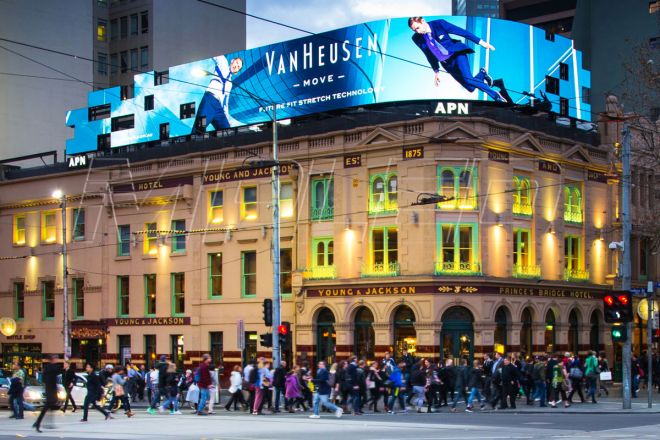
As a unique and conspicuous display space, the roof has become a popular choice for LED display installation. However, the particularity of the rooftop environment makes the installation process more challenging than in ordinary environments.
This article will give you all the important details about LED display roof installation. Let’s take a look.
1. Advantages and disadvantages of roof installation
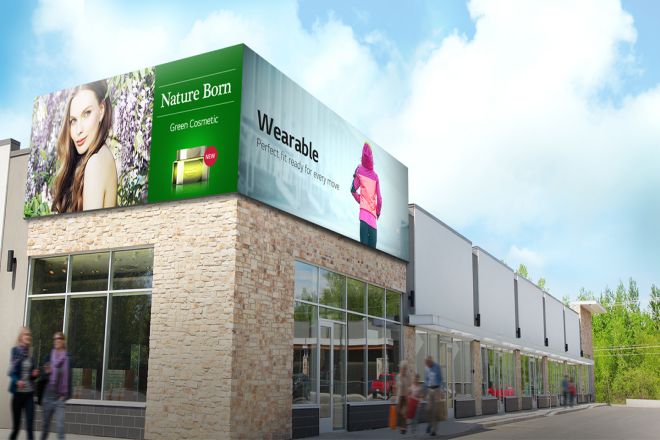
Installing LED displays on the roof is now the choice of many people, but do you understand the advantages and disadvantages of installing LED displays on the roof?
Advantage:
Broad field of view and good communication effect: The high roof position and wide field of view allow the LED display to cover a wider area, attracting people’s attention whether it is day or night and achieving a good communication effect.
Strong environmental adaptability: The LED display screen installed on the roof can withstand the erosion of natural environments such as wind and rain and has strong environmental adaptability.
Personalized customization: It can be customized according to the characteristics of the building and the needs of the owner so that the LED display screen can be integrated with the building to improve the overall aesthetics.
Disadvantages:
Installation and maintenance are difficult: Roof installation requires consideration of the building’s load-bearing, waterproofing, lightning protection, and other issues, and the installation process is relatively complicated. At the same time, due to the higher position of the roof, later maintenance also requires more effort.
Safety issues: Roof installation involves high-altitude operations, which poses certain safety risks. During the installation process, safety operating procedures need to be strictly followed to ensure the safety of construction personnel.
Higher cost: Due to the difficulty of installation and maintenance, the cost of installing LED displays on the roof is usually higher than that of indoor installation.
2. Which LED displays are suitable for roof installation?
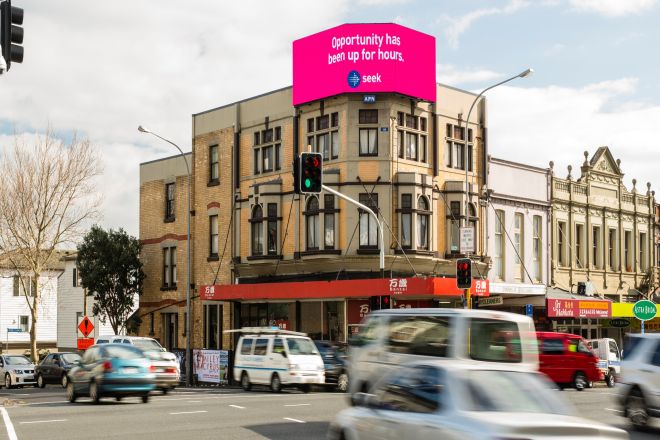
The LED display screen suitable for roof installation mainly depends on many factors, including the structure of the roof, load-bearing capacity, surrounding environmental conditions, budget, and required display effects. Here are some types of LED displays that are typically suitable for rooftop installation:
- Lightweight LED display: Due to the limitation of roof load-bearing capacity, choosing a lightweight LED display is an important consideration. Such displays are typically made from lightweight materials, reducing stress on the roof structure.
High protection level LED display: The rooftop environment is usually exposed outdoors, so it is necessary to choose an LED display with a high protection level. These displays are usually waterproof, dustproof, and UV-resistant, making them resistant to harsh weather conditions and ensuring long-term stable operation.
LED display with adjustable angle and brightness: Depending on the specific location of the roof and the brightness of the surrounding environment, choosing an LED display with adjustable angle and brightness can better meet viewing needs. This allows the display’s brightness and viewing angle to be adjusted according to different times of day and weather conditions, ensuring optimal visual effects.
Customized LED display: Depending on the shape, size, and installation requirements of the roof, you can choose a customized LED display. Customized displays can better adapt to the roof structure, achieve seamless connection, and improve the overall aesthetics and visual effects.
It should be noted that when choosing an LED display suitable for roof installation, communication and cooperation with the installation company should also be considered. A professional installation company can provide suitable display options based on the specific conditions and needs of the roof and ensure a safe and smooth installation process.
Finally, no matter which type of LED display is chosen, sufficient survey and planning are required before installation to ensure that the installation location, load-bearing capacity, surrounding environment, and other factors of the display meet the installation requirements to ensure the stable operation of the display. And usage effects.
3. LED display roof installation method
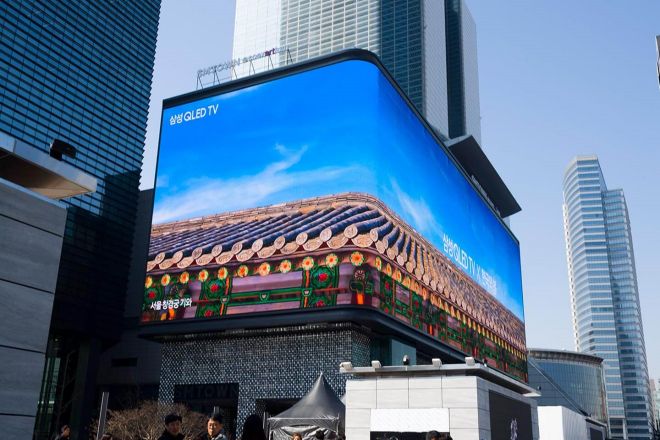
When installing LED displays on the roof, a rigorous installation method must be followed to ensure the safety, stability, and efficiency of the installation process. The following are specific installation steps and precautions:
- Preliminary preparation
Before installing an LED display, adequate preparation is essential. First of all, a detailed evaluation of the roof structure, including load-bearing capacity, waterproof performance, etc., is required to ensure that the roof can withstand the weight of the display and possible wind pressure.
Secondly, the size, resolution, and brightness of the display screen are determined based on factors such as usage requirements, viewing distance, and roof area to achieve the best display effect. Finally, detailed installation location diagrams and wiring plans should be drawn to ensure an orderly installation process.
- Installation steps
The installation step is the most critical part of the entire installation process.
First, a stable support frame should be built according to the installation location diagram and plan. The material and structure of the support frame should be carefully designed to ensure that it can withstand the weight of the display and the impact of the external environment.
Secondly, the display modules are installed one by one according to the layout and splicing method of the display modules. During the installation process, special attention should be paid to the alignment and splicing between modules to ensure the flatness and beauty of the display.
Next, connect the power and signal lines to ensure a stable power supply and stable signal transmission.
Finally, system debugging and calibration should be carried out to check the display effect, brightness, contrast, and other parameters of the display to ensure the best condition.
- Post-installation inspection and testing
After installation is completed, the display needs to undergo a series of inspections and tests to ensure its normal operation and safety. First, check the flatness and stability of the display to make sure there are no loose or tilted issues. Secondly, the display effect and color are calibrated to ensure accurate color and uniform brightness.
Finally, the system operation stability and safety tests are conducted, including the stability of the power supply, reliability of signal transmission, and the effectiveness of safety measures such as lightning protection.
During the entire installation process, some details need to be considered. For example, during the installation process, you must strictly abide by safe operating procedures and wear the necessary protective equipment.
When installing display modules, ensure that the connections between modules are firm and well-sealed; when connecting power and signal lines, pay attention to the direction of the lines and fixing methods to avoid causing safety hazards or affecting aesthetics.
4. LED display roof installation precautions
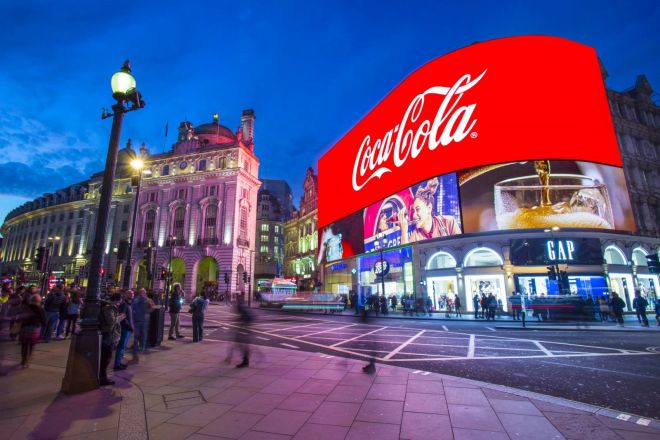
When installing an LED display on the roof, in addition to following certain installation methods, you also need to pay attention to details in many aspects to ensure the safety of the installation process and the normal operation of the display. The following are specific considerations:
- Legal aspects
Before installing an LED display, the first priority is to ensure that you have a legal installation license. This involves communication and coordination with local governments or relevant management departments to ensure that installation activities comply with legal and regulatory requirements. Installation without permission may result in legal risks and penalties.
- Security measures
Comply with safe operating procedures: During the installation process, all workers must strictly abide by safe operating procedures and must not violate safety regulations. This includes using tools and equipment correctly, avoiding overhead objects, keeping work areas tidy, etc.
Wear protective equipment: Workers should wear necessary protective equipment, such as hard hats, gloves, safety belts, etc., to protect themselves from injury.
Ensure the insulation and protection of power and signal lines: Power and signal lines must have good insulation properties to prevent leakage or short circuits. At the same time, the lines should be properly fixed and protected to avoid being stepped on or pulled to ensure stable transmission and safety.
Consider lightning protection and grounding measures: When installing an LED display on the roof, lightning protection and grounding measures must be considered. Install lightning rods or lightning strips to protect the display from lightning strikes. At the same time, the metal frame and power lines of the display screen should be grounded to reduce electromagnetic interference and static electricity hazards.
- Environmental adaptability
Consider the impact of wind, temperature, and humidity on the roof: The roof environment is usually harsh, and the impact of wind, temperature, humidity, and other factors on the display needs to be considered. Choose display products with good wind resistance, high and low-temperature resistance, and moisture and humidity resistance.
Choose a display with good waterproof, dustproof, and UV-resistant properties: Roof-mounted displays are exposed to the outdoor environment for a long time, so they must be waterproof, dustproof, and UV-resistant. Choosing products with these properties ensures that the display will still function properly in harsh weather conditions.
Regular inspection and maintenance: Regular inspection and maintenance of the display screen is the key to ensuring its long-term stable operation. Check the fixation of the display screen, line connections, waterproof and dustproof performance, etc., and find and solve problems in time. At the same time, cleaning and maintaining the display screen can extend its service life and maintain good display effects.
- Visual effects and layout
Choose the right display shape and size based on the roof structure: Different roof structures may have restrictions on the installation location and size of the display. When choosing a display screen, you should fully consider the structural characteristics of the roof and choose the appropriate shape and size to achieve the best visual effect.
Reasonably arrange the viewing angle and distance of the display screen: The viewing angle and distance of the display screen have an important impact on the visual effect. During installation, the viewing angle and distance of the display should be reasonably arranged to ensure that the audience can clearly see the content of the display while avoiding visual fatigue or discomfort.
Consider coordination with the surrounding environment: Roof-mounted displays usually exist as part of the building, so coordination with the surrounding environment needs to be considered. When selecting the color, style, and layout of the display screen, try to coordinate with the overall style of the building to enhance the overall visual effect.
Conclusion
To sum up, the roof installation of LED displays is a complex and delicate task, which requires us to fully understand and master the relevant installation methods and precautions. Through the introduction and summary of this article, I hope to provide you with valuable reference and guidance.
Finally, if you still want to know more about LED displays, please get in touch with us.
